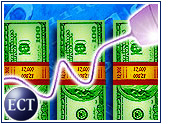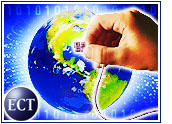
Want to figure out if you’re a pessimist or an optimist in the Internet age? Forget the glass half-full, glass half-empty question.
Try this instead: comScore says more than 50 percent of the U.S. population used the Internet last month, the first time this has ever happened. Your reaction to that news — beyond momentary shock at the size of the numbers, with 150 million Web users — says a lot about your personality.
Is That All?
A gloom-and-doom person might ask what took so long or why, after a solid decade of Internet use by regular people (as opposed to academics or computer geeks), only half of Americans are still online. Those people see the half of the population not on the Internet as a gap — the living, breathing embodiment of the digital divide.
Frankly, that’s a valid point. Computers are so inexpensive as to be disposable, and Internet access is cheaper than HBO. Each school or library has Web access. And a full third of all U.S. workers have access to the Web at work.
So, what’s holding back the other half? If it were only a matter of time, shouldn’t a decade have eroded the number of resistors by more than half?
Those pessimists probably also would argue that the 50 percent level serves as proof of the Internet’s shortcomings. After all, comScore says the bump in online bodies occurred as a result of one-time events like hurricanes and seasonal surges like back-to-school. If the Web’s so great, the doom-and-gloom crowd could say, why does it take special circumstances to get all the way to the halfway point?
Happy Days
At the other end of the spectrum, the optimists see the 50 percent threshold as a gateway to nirvana. Imagine it: phenomenal growth in e-commerce, in paid content use, in legitimate music downloading and so on — all of it with just half of the country online.
Why did we ever worry about whether Amazon and eBay could sustain their growth rates? The sky’s not the limit anymore; it’s just another barrier the Web can bust through like all the others.
Think about it — the Web has spent the past two years maturing, a process that’s supposed to kick in after the rapid growth is all said and done. But we’ve got another 140 million Americans to bring on board. That should be good for another spurt or two.
Even if we wrestle a measly 5 percent of the holdouts online each year, that’s about 750,000 people.
Split the Difference
As usual, the truth lies somewhere in the middle, at some balance of the two extreme perspectives. But there does seem to be something different about this milestone. For one thing, the odds of the Web going backward are slim. It’s all uphill from here — or is it?
Benchmarks are helpful, but getting caught up in the numbers is also a trap. The underlying message is that more people are finding the Web a useful, practical and even necessary place to be. That even one person, let alone 150 million, can say that about a technology is pretty amazing.



























































Social Media
See all Social Media